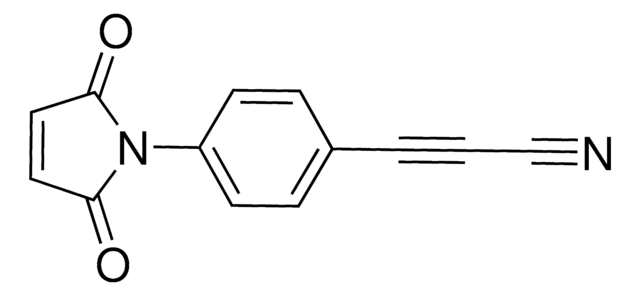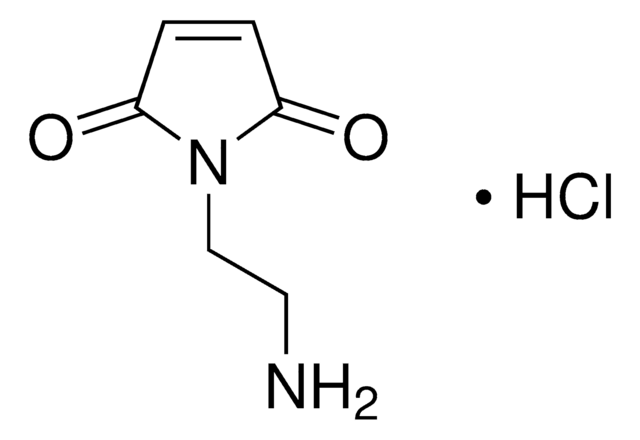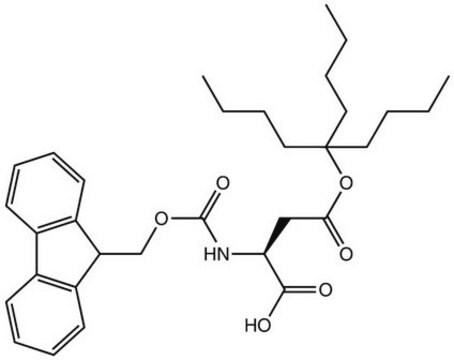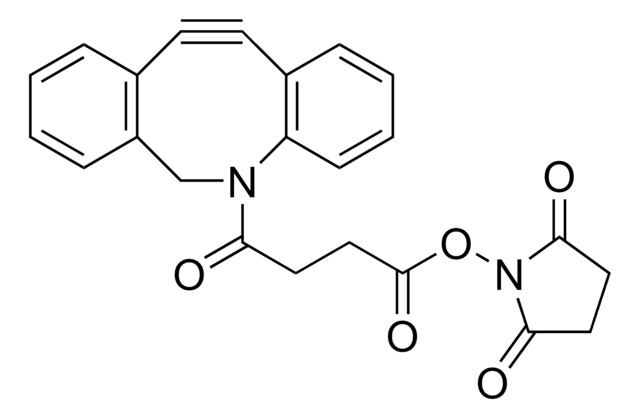추천 제품
형태
powder
Quality Level
반응 적합성
reagent type: cross-linking reagent
작용기
ester
저장 온도
−20°C
SMILES string
O=C(OC1=C(F)C(F)=C(S(=O)(O[Na])=O)C(F)=C1F)C2=CC=C(C#CC#N)C=C2
InChI
1S/C16H5F4NO5S.Na/c17-10-12(19)15(27(23,24)25)13(20)11(18)14(10)26-16(22)9-5-3-8(4-6-9)2-1-7-21;/h3-6H,(H,23,24,25);/q;+1/p-1
InChI key
YFJYSJRZDOWXDH-UHFFFAOYSA-M
일반 설명
CBTF (Sodium 4-((4-(cyanoethynyl)benzoyl)oxy)-2,3,5,6-tetrafluorobenzenesulfonate) is a heterobifunctional reagent. It bears a 3-arylpropionitrile (APN) group. CBTF can be prepared from 4-iodobenzoic acid. It participates in various amine-to-thiol coupling reactions. It participates in the synthesis of various antibody-dye conjugates. CBTF is widely used for antibody conjugation.
애플리케이션
CBTF is a bifunctional crosslinker for amine-to-thiol coupling. The coupling can be performed with high selectivity in biological medium using mild reaction conditions. CBTF readily reacts with organic amines in basic conditions to produce APN-probes suitable for cysteine labeling.
기타 정보
Standard protein labeling procedure (lysine labeling):
Standard protein labeling procedure (cysteine labeling):
Dissolve the protein in the appropriate buffer* with pH 6.5-9.0 (e.g. PBS) at 1-10mg/mL concentration.
Apply the appropriate amount of the stock solution of the APN-labeled molecule (1-5 molar eq. per free cysteine residue).
Incubate at room temperature for 2 hours.
If necessary, purify the protein conjugate using size exclusion chromatography or ultrafiltration.
*Note: avoid amine- and thiol-containing buffers.
- Dissolve the protein in an appropriate buffer* with pH 7.5-9.0 (e.g. PBS) at 1-10mg/mL concentration.
- Apply the appropriate amount of the stock solution of the reagent (1-5 molar eq. per lysine residue).
- Incubate at room temperature for 2 hours.
- If necessary, purify the protein-APN conjugate using size exclusion chromatography or ultrafiltration.
- The conjugate can be readily coupled with thiol-containing substrates by incubating the components in aqueous buffer (pH 6.5-9.0) at ambient temperature for 2 hours.
Standard protein labeling procedure (cysteine labeling):
Dissolve the protein in the appropriate buffer* with pH 6.5-9.0 (e.g. PBS) at 1-10mg/mL concentration.
Apply the appropriate amount of the stock solution of the APN-labeled molecule (1-5 molar eq. per free cysteine residue).
Incubate at room temperature for 2 hours.
If necessary, purify the protein conjugate using size exclusion chromatography or ultrafiltration.
*Note: avoid amine- and thiol-containing buffers.
신호어
Danger
유해 및 위험 성명서
예방조치 성명서
Hazard Classifications
Acute Tox. 3 Oral
Storage Class Code
6.1C - Combustible acute toxic Cat.3 / toxic compounds or compounds which causing chronic effects
WGK
WGK 3
Flash Point (°F)
Not applicable
Flash Point (°C)
Not applicable
이미 열람한 고객
Houzong Yao et al.
International journal of molecular sciences, 17(2), doi:10-doi:10 (2016-02-06)
Antibody-drug conjugates (ADCs) have become a promising targeted therapy strategy that combines the specificity, favorable pharmacokinetics and biodistributions of antibodies with the destructive potential of highly potent drugs. One of the biggest challenges in the development of ADCs is the
Construction of homogeneous antibody-drug conjugates using site-selective protein chemistry.
Akkapeddi P, et al.
Chemical Science, 7(5), 2954-2963 (2016)
Sergii Kolodych et al.
Bioconjugate chemistry, 26(2), 197-200 (2015-01-24)
Amine-to-thiol coupling is the most common route for the preparation of antibody-drug conjugates (ADC). It is usually achieved by using heterobifunctional reagents possessing an activated ester at one end and a maleimide group at the other. However, maleimide-based conjugates were
자사의 과학자팀은 생명 과학, 재료 과학, 화학 합성, 크로마토그래피, 분석 및 기타 많은 영역을 포함한 모든 과학 분야에 경험이 있습니다..
고객지원팀으로 연락바랍니다.![LC-SPDP (succinimidyl 6-[3(2-pyridyldithio)propionamido]hexanoate)](/deepweb/assets/sigmaaldrich/product/structures/300/586/d95fd80c-e201-4b0b-8aee-31e109c2ff41/640/d95fd80c-e201-4b0b-8aee-31e109c2ff41.png)









